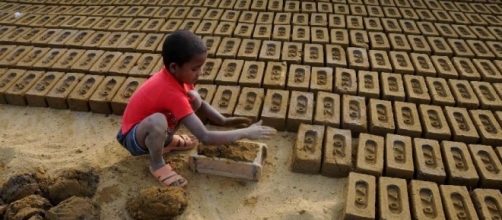What is the definition of child labour? These are small Children who are constantly placed at work and mostly deprived of going to school and enjoying their precious childhood. Child labour is banned in many countries and considered so by many international organisations due to the physical and psychological damages inflicted.
“The United Nations Convention on the Rights of the Child (commonly abbreviated as the CRC or UNCRC) is a human rights treaty which set out the civil, political, economic, social, health and cultural rights of children,” as described by Wikipedia.
This text aims to defend children’s rights and was adopted in 1990 after ten years of negotiations amongst the UN Member States.
June 12th is commemorated as Child Labor Day to raise awareness annually on this issue and prevent the spread of this deplorable phenomenon.
The situation in Iran
In iran under the mullahs’ rule, however, there are cases of children being sold or families having no choice but sending them off to work. Poverty imposed by the mullahs’ regime is forcing parents to such measures in order to make ends meet.
There are no exact statistics of how many labour children can be found in Iran.
“Around 3 million children are working across the country, according to government organisations.
However, investigations carried out by popular organisations indicate over 7 million such children spread throughout Iran. Government statistics show around 20,000 such labour children in Tehran alone. In various areas, these children lack any official identification papers and small girls are also seen working as maids.
Most labour children are forced to accept arranged marriages once they reach the age of 10 to 12, according to Tehran’s City Council Social Committee Chairman.
Most of these children are deprived of any education as official numbers show at least 30% of these children don’t go to school, 31% are aged between 6 to 11 and 9% are actually below the age of 6. Unbelievably, 60% of these children are their families’ only source of income.
With each passing day reports show such labour children are involved in a variety of different areas of work.
Some are even used to clean the carcases of animals killed for meat. Some are involved in household jobs, others in factories and even carrying heavy loads in provinces bordering neighbouring countries where smugglers are active.
Contracting firms are known to use Afghan migrants’ children to search trash fields for a variety of goods that may be found for sale.
Even more numbers
Research shows 45% of labour children and those living on the streets are suffering from illnesses such as AIDS, hepatitis and others. These children are also known to be suffering from malnutrition, being short in height, low weight, skin illnesses and psychological disorders.
Many such children work at least 6 hours a day and don’t eat even a single decent meal, providing the grounds for these children to obtain even more illnesses.
A large number of these children are seen carrying heavy loads and begin suffering from back problems at a very early age. And since they have no access to medical care, such an illness paves the path for even more problems further down the road.
Despite enduring all this suffering these children only receive one fifth of a normal worker’s salary. However, a long slate of risks continuously threatens their lives. If they suffer any injuries, there is no entity willing to provide any support at all.
Those children who are obligated to help their families make ends meet, those who do not have proper IDs, find themselves being sold by their families, not knowing where they will end up.
Iran’s children are suffering from such conditions while year after year the regime provides huge budgets for its vast security, military, political and propaganda machine. For example, 150 trillion tomans (around $42.86 billion) is allocated to state-run TV and radio stations.

